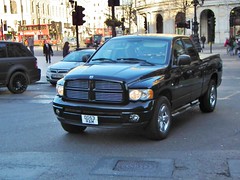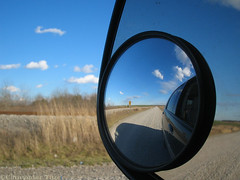Yesterday a large, black, Chevy truck rode right on my tail as I brought my daughter home from daycare. Even though I knew it was a cop-infested stretch of road, I found myself going 15 mph above the speed limit.

Just ignore him, I kept telling myself, but every time I took my foot off the accelerator, he'd loom large in my rear-view mirror and I couldn't help but speed back up. When he finally turned, the release of tension was palpable. What that sound?, my toddler asked in response to my exhalation.
It was ridiculous. Some stranger in a car behind me could affect my actions that much? I was making the decisions about when to gas it and when to brake. Why did it feel like he was the one dictating the drive?
This got me to thinking about my undergraduates. As I talk to them about their lives and their future plans, all too often everyone and everything imaginable leaps into the conversation. We're suddenly having a chat about their parents, other professors, their friends, "society."
It's your car, I tell them in far too many words. Why are you letting everybody else drive your life?
Because those people and things are the menacing black Chevy in their rear-view mirrors. And maybe in yours.
With this analogy in mind, I challenge you to take fifteen minutes and answer some questions for yourself - on paper. (Yes, writing it down makes a difference. Prof says so.) With any luck, at the end you just might feel like the hulking Chevy has finally turned, leaving you free to roam down the road at your own pace.
1. How often do you look in your rear-view mirror?
Are you someone obsessed with monitoring everything and everyone around you (that's me), or are you able to block the world out and live according to your own devices? If you're the former, you're going to have to learn how to block out the menacing cars in your rear-view.
If you're the latter, you're not off the hook; you might be going too fast and could benefit from looking around and seeing some "slow down" signals once in a while.
2. At what speed do you naturally travel?
When it comes to life, what's your natural speed of travel? Are you someone who likes to go 50 in a 35? Or do you prefer to go precisely the speed limit, or just a few notches above? Perhaps you're someone who likes to keep things slow; you're the car chugging along in the right lane of the highway, doing a steady 45 in the 65. (I do curse you at times, I must admit.)
None of these paces is necessarily "wrong." But if going the speed limit translates into doing what's developmentally appropriate for your age, then perhaps there's something to be said for sticking somewhat close to it. If you go "too fast" you might surpass your abilities and find yourself in uncomfortable, overwhelming circumstances. If you go "too slow," however, you might miss out on opportunities and fail to push yourself out of your comfort zone.
In any event, it's important to know how you like to travel, before considering how others influence your travel.
3. Who and/or what is in your rear-view mirror?
Now it's time for some brainstorming. Create a list of everything that influences you, whether it be positively or negatively. Try to get as specific as you can. For instance, if you talk about "society" affecting you, what exactly do you mean?
Then rank the list. Which affects you most, and which the least?
4. What effect does each of the entities in your rear-view have on your natural speed?
Next to your ranked list, write a "SU" next to the entities that make you "speed up" or that push you in some way. Put a "N" next to entities that have a neutral effect on your speed. And write a "SD" next to the ones that in some way encourage you to slow down.
Reflect back on your natural speed from Q1. Do you think you should, in general, be traveling faster or slower than you naturally do? This tells you whether "SU," "SD," and "N" are positive or negative for you. For example, if you typically drive the speed limit, both the "SU" and "SD" influences may be negative; but if you naturally drive too fast, the "SD" people may be great and the "N" people may be questionable.
With this in mind, circle the entities that have a negative effect on you, and star the ones that have a positive effect.
5. For the entities that are affecting your speed negatively, how can you "black out" your rear-view mirror?
The starred entities are the ones you should have in your rear-view mirror in unlimited measures. They're the people and things you need to glance back and see on a regular basis, so don't let yourself forget that they're there.
The circled, negative entities, though - my big, black Chevy, as it were - need to be handled. You don't need them out of your life - they're probably adding much to your existence, even if they're affecting your speed inappropriately - you just need to learn to stop seeing them when you're driving. So do something totally illegal: black out that rearview mirror!
You especially need to "black it out" when you're about to "make a turn." Decision points are the most crucial moments to ignore what's behind you or you may very well go the wrong way, like we discussed in our recent class on regret.
So your final task is to brainstorm strategies to black out the mirror. The strategies need to be specific to you, but might include:
- Finding ways of distracting yourself from the lurking entities. Think of it as turning the radio way up and singing your heart out during the drive.
- Creating a mantra that resonates for you that you can repeat when you feel the influences bearing down. Something like "I'm driving, I'm in control, this is my car."
- If you're a visual person, closing your eyes and literally picturing yourself in a car with black paint smeared across the back window. See yourself in the enclosed space all alone, free to think without distraction. Feel what it's like in this space, in as much detail as you can muster, using all five senses (just what does an empty car taste like?!). If the thought of being alone in the car makes you feel anxious rather than relaxed, then pop a starred person from Question 3 into the passenger seat. Feel better?
All in all, I wish you safe and happy travels, full of the knowledge that the only person with the foot hovering over the pedals is you. There may be an entourage rivaling the President's motorcade trailing behind you, but they can't drive your car.
If only that had worked with my huge Chevy.
My intimidator looked a lot like this. But I swear it was a Chevy. Not that I really know car makes... (Photo credit: kenjonbro)
There's too much clutter back there. (Photo credit: ChristopherTitzer)
Are you traveling in the right zone? (Photo credit: Wikipedia)
Seems pretty neutral to me. (Photo credit: eschulz)
Make that back window nice and dark! (Photo credit: aresauburn™)




